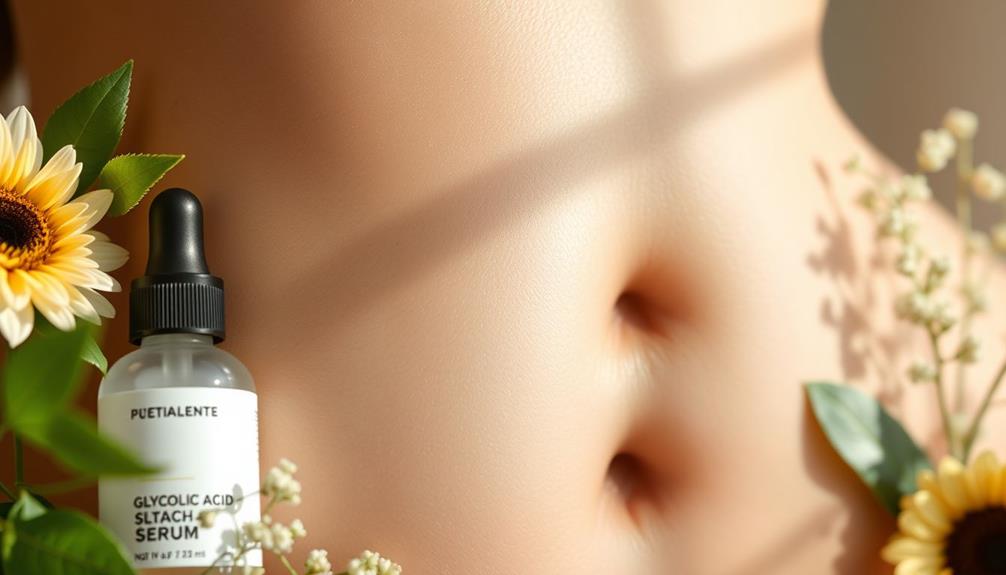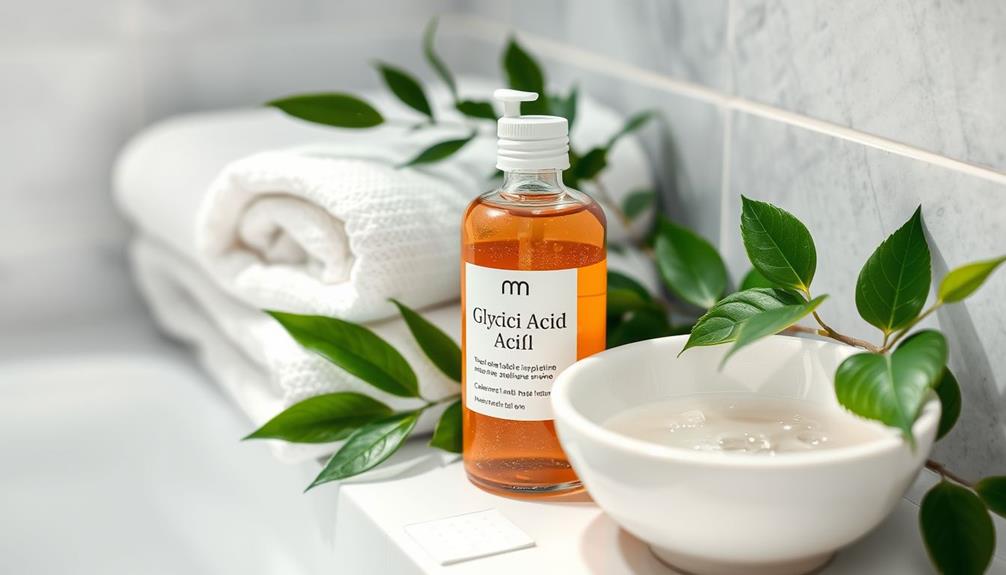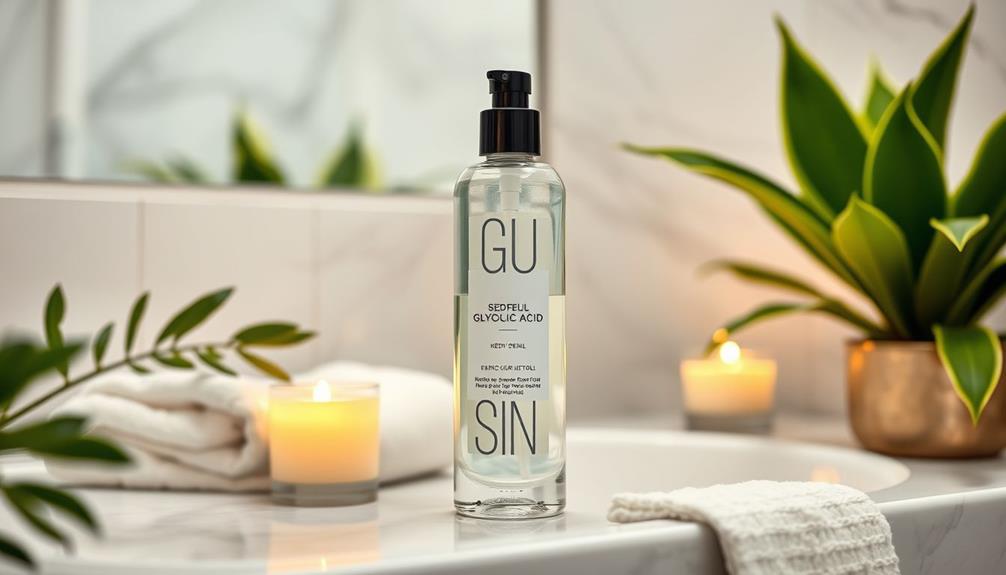Top dermatologists highlight glycolic acid as a powerhouse for your skin. This alpha-hydroxy acid exfoliates dead skin cells, revealing a brighter, smoother complexion. It effectively reduces fine lines and hyperpigmentation while supporting collagen production for improved elasticity. Using glycolic acid can also minimize enlarged pores and prevent acne breakouts. However, it can increase skin sensitivity, making sunscreen essential. Start with a lower concentration and gradually increase usage to find what works for you. With proper application and care, you can enjoy significant benefits. Keep exploring to uncover more insights on how to maximize glycolic acid for your skincare routine! Many people wonder, “Can glycolic acid help acne?” The answer is yes! Glycolic acid is known for its ability to exfoliate and cleanse the skin, helping to prevent acne breakouts and promoting clearer, healthier skin. It works by unclogging pores and reducing the buildup of dead skin cells, which are common contributors to acne. When used consistently and in the right concentrations, glycolic acid can be a powerful ally in your fight against acne.
Key Takeaways
- Glycolic acid exfoliates dead skin cells, improving texture and promoting a brighter complexion.
- It stimulates collagen production, effectively reducing fine lines and enhancing skin firmness.
- Dermatologists recommend starting with lower concentrations and gradually increasing usage to monitor skin reactions.
- It's effective for treating hyperpigmentation, including dark spots and melasma, by regulating melanin production.
Understanding Glycolic Acid
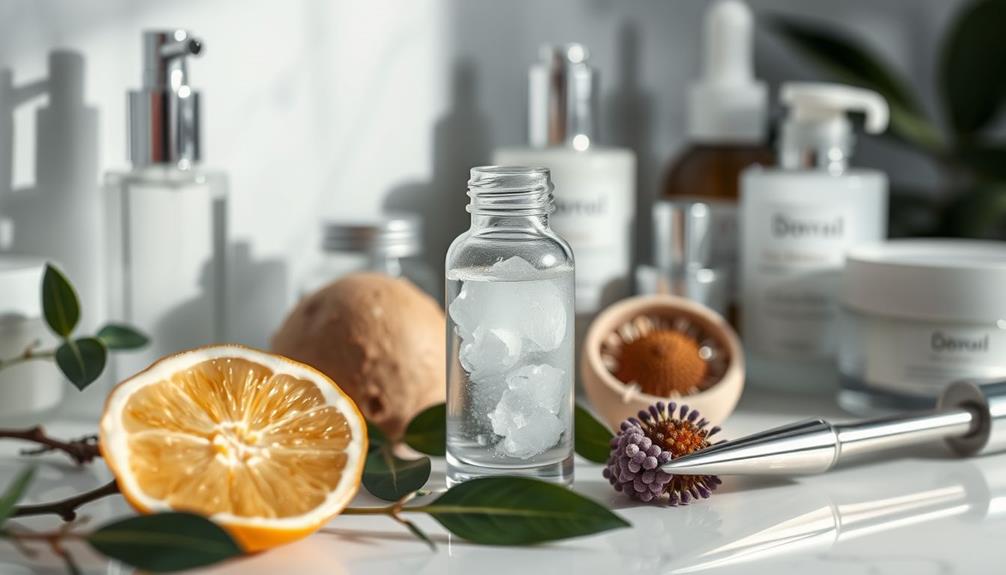
Glycolic acid, a powerful alpha-hydroxy acid derived from sugar cane, penetrates deeply into your skin to promote effective exfoliation and rejuvenation. This small-molecule acid is known for its ability to enhance cell turnover, making it a popular choice in skincare routines aimed at improving skin texture.
By sloughing off dead skin cells, glycolic acid helps reduce hyperpigmentation and fine lines, resulting in a brighter and smoother complexion. Additionally, incorporating essential oils for skin health can further enhance your skincare routine, offering additional therapeutic benefits.
When you incorporate glycolic acid into your regimen, it stimulates collagen production, which is crucial for maintaining your skin's elasticity and firmness. However, it's important to be cautious, as glycolic acid can increase your skin sensitivity, particularly to UV rays. This means that daily application of broad-spectrum sunscreen becomes essential to protect your skin while using glycolic acid products.
For home use, concentrations typically range from 5% to 10%, and it's wise to introduce this ingredient gradually. This can help minimize irritation and allow your skin to adjust. Understanding how glycolic acid works will empower you to optimize its benefits and achieve healthier, more radiant skin.
Key Benefits for Skin
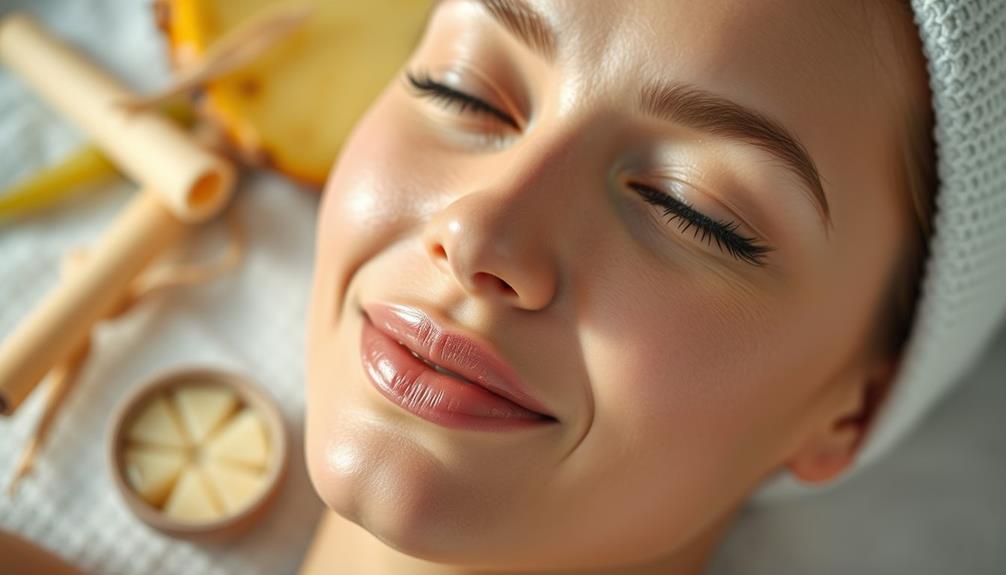
When you use glycolic acid in your skincare routine, you'll notice a range of key benefits that enhance your skin's overall appearance and health. One of the primary advantages is its ability to improve skin texture through exfoliating dead skin cells, making your complexion look smoother and more radiant.
Additionally, glycolic acid can greatly reduce fine lines and wrinkles by boosting collagen production, which enhances skin firmness and elasticity. For those looking to complement their skincare routine, incorporating essential oils such as lavender oil for relaxation can further enhance your overall skin health and well-being.
If you're concerned about hyperpigmentation, glycolic acid can help fade dark spots and sun damage by sloughing off the upper layers of skin and decreasing excess melanin production. Its effectiveness extends to minimizing the appearance of enlarged pores, which helps prevent acne breakouts by clearing clogged pores and stopping dead skin from mixing with sebum.
Moreover, glycolic acid works well alongside hyaluronic acid, ensuring your skin maintains proper moisture levels. This combination not only hydrates but also prevents dryness, making glycolic acid a versatile and essential ingredient in your skincare arsenal.
With these benefits, incorporating glycolic acid can lead to healthier, more vibrant skin.
Recommended Usage Guidelines
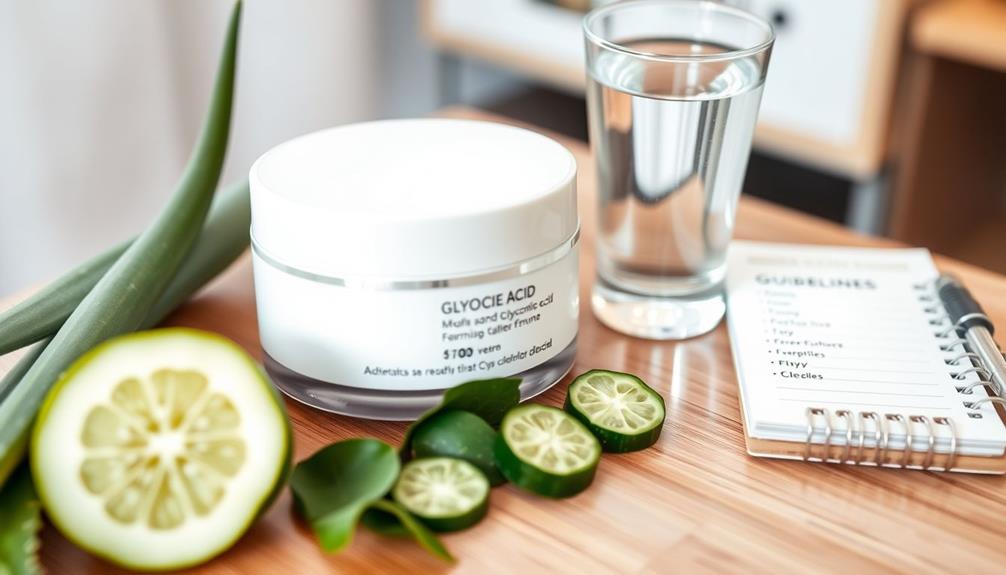
To guarantee you get the most out of glycolic acid, start with lower concentrations and gradually increase usage as your skin adjusts. Incorporating a consistent skincare routine can enhance overall skin health and may help with issues such as irritation yoga for back pain management. Here are some recommended usage guidelines to follow:
- Start Small: Use a concentration of glycolic acid between 5-10% and apply it 1-3 times per week.
- Timing Matters: Apply glycolic acid products at night on cleansed skin. This reduces the risk of UV sensitivity, so remember to use broad-spectrum sunscreen during the day.
- Give It Time: Wait 20-30 minutes after cleansing to allow your skin's pH to normalize before you apply glycolic acid for peak effectiveness.
- Avoid Over-Exfoliation: Don't combine glycolic acid with other exfoliating chemical exfoliants like salicylic acid or retinol on the same days to prevent irritation, especially if you have sensitive skin.
Always monitor skin reactions closely. If you experience irritation, reduce the frequency or concentration of glycolic acid. If issues persist, consult a dermatologist for personalized advice. Following these guidelines will help you effectively incorporate glycolic acid into your skincare routine while minimizing potential side effects.
Compatibility With Other Ingredients
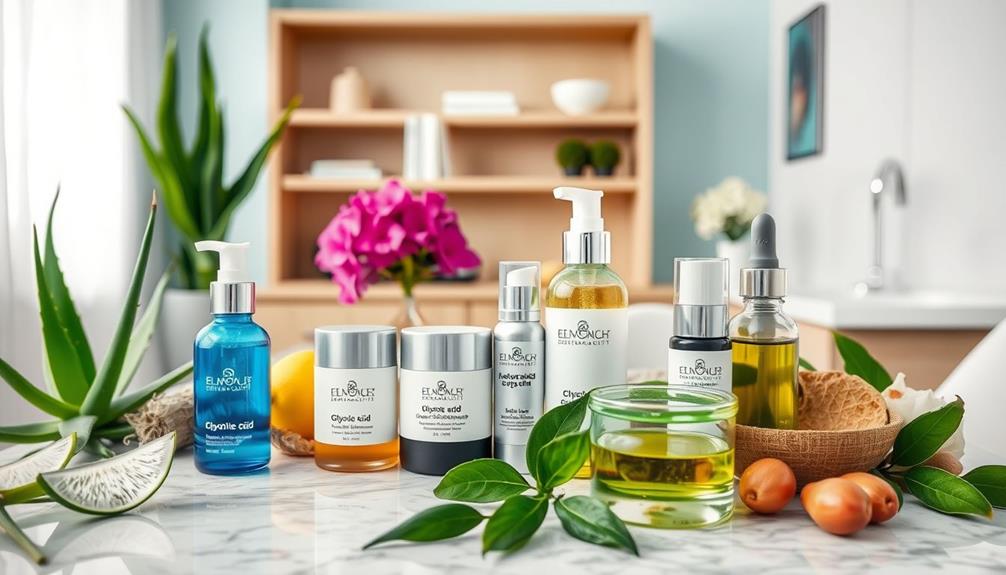
Understanding how glycolic acid interacts with other ingredients is essential for optimizing your skincare routine and avoiding potential irritation. Dermatologists recommend being cautious with ingredient combinations to prevent skin sensitivity.
| Ingredient | Compatibility | Recommendation |
|---|---|---|
| Vitamin C | Incompatible | Avoid using together due to pH levels |
| Retinol | Incompatible | Alternate nights to reduce irritation |
| Hydrating Ingredients | Compatible | Use with hyaluronic acid for moisture retention |
Mixing glycolic acid with other AHAs, like lactic acid, can lead to excessive exfoliation, so it's best to steer clear of that combo. Additionally, benzoyl peroxide may cause irritation when paired with glycolic acid; consider using them on separate days. On the flip side, layering glycolic acid with hydrating ingredients helps combat dryness from exfoliation and enhances moisture retention. By understanding these interactions, you can effectively incorporate glycolic acid into your routine without compromising your skin's health. Always consult with dermatologists if you're unsure about your specific skin needs.
Dermatological Insights and Research
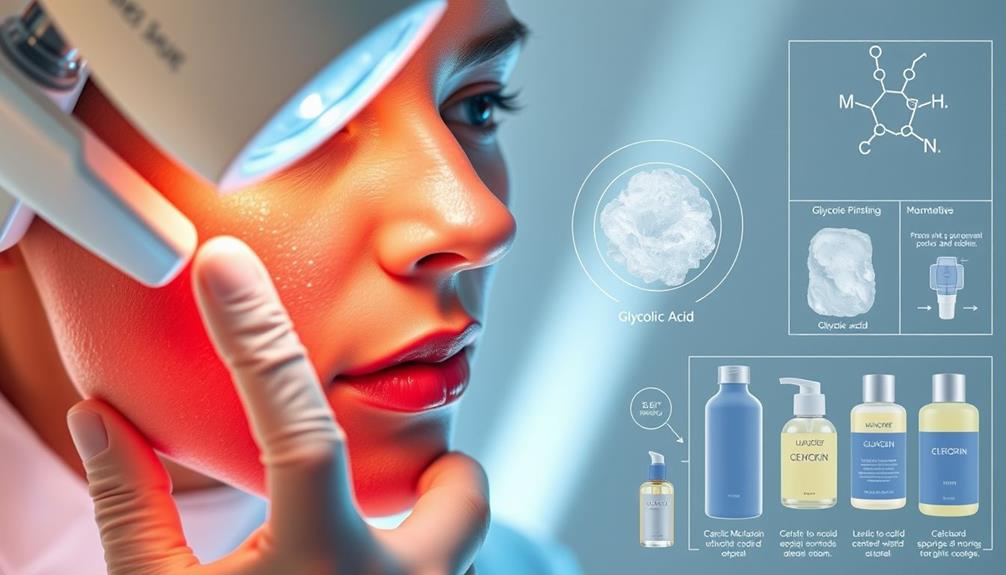
Recent research underscores glycolic acid's unique ability to penetrate the skin effectively, making it a powerful tool for enhancing exfoliation and improving overall skin texture. Here are some key insights:
- Glycolic acid stimulates collagen production, which helps reduce fine lines and wrinkles.
- It's effective for treating hyperpigmentation, including melasma, by promoting the removal of excess melanin.
- The acid enhances moisture retention through increased hyaluronic acid production, leading to plumper skin.
- Glycolic acid is valuable for acne management, aiding in skin renewal without causing proinflammatory effects.
Dermatologists emphasize that using glycolic acid as a chemical exfoliant can yield significant benefits when applied correctly.
With concentrations typically ranging from 5% to 30%, it addresses various skin concerns effectively.
Whether you're looking to refine your skin texture or tackle issues like acne and hyperpigmentation, glycolic acid proves to be a versatile ally.
By incorporating this AHA into your skincare routine, you can enjoy the dual benefits of exfoliation and hydration, ultimately achieving a brighter, healthier complexion.
Always consult with a dermatologist to tailor the use of glycolic acid to your unique skin needs for ideal results.
Frequently Asked Questions
What Do Dermatologists Say About Glycolic Acid?
Dermatologists say glycolic acid's an effective exfoliant that improves skin texture and reduces fine lines. They recommend starting with lower concentrations, gradually incorporating it, and always using sunscreen to protect your skin from increased UV sensitivity.
What Effect Does Glycolic Acid Have on the Face?
You might worry about irritation, but glycolic acid effectively exfoliates your skin, enhancing texture and brightness. It reduces fine lines, minimizes pores, and tackles hyperpigmentation, leaving you with smoother, healthier skin over time.
What Are the Bad Side Effects of Glycolic Acid?
Glycolic acid can cause irritation, redness, and peeling, especially if you overuse it. It might increase sensitivity to sunlight too, so you'll need effective sun protection to avoid further damage to your skin.
What Percentage of Glycolic Acid Do Dermatologists Use?
Dermatologists typically use glycolic acid concentrations between 20% and 70% for professional peels, while recommending 5% to 10% for at-home products. Starting with lower percentages helps minimize irritation and enhances your skin's overall texture.
Conclusion
Incorporating glycolic acid into your skincare routine can transform your complexion, providing smoother and brighter skin.
With its ability to exfoliate and boost collagen, it's no wonder dermatologists recommend it.
But have you considered how it might work alongside your other products?
By following the right usage guidelines and understanding compatibility, you can maximize its benefits.
So, why not take the plunge and see how glycolic acid can elevate your skincare game?
Your skin deserves it!



